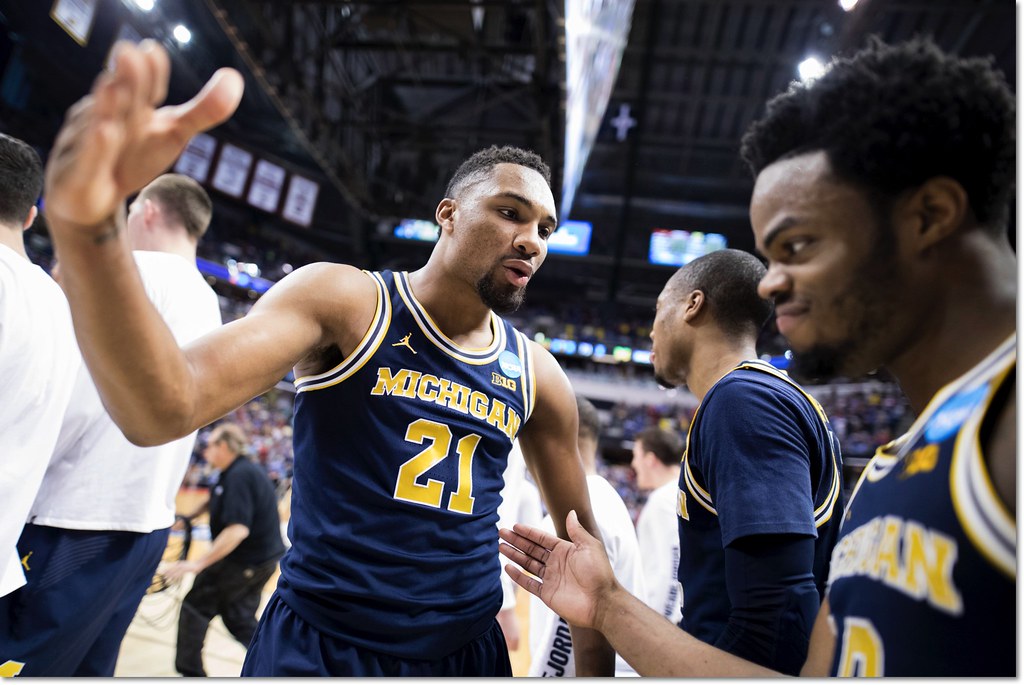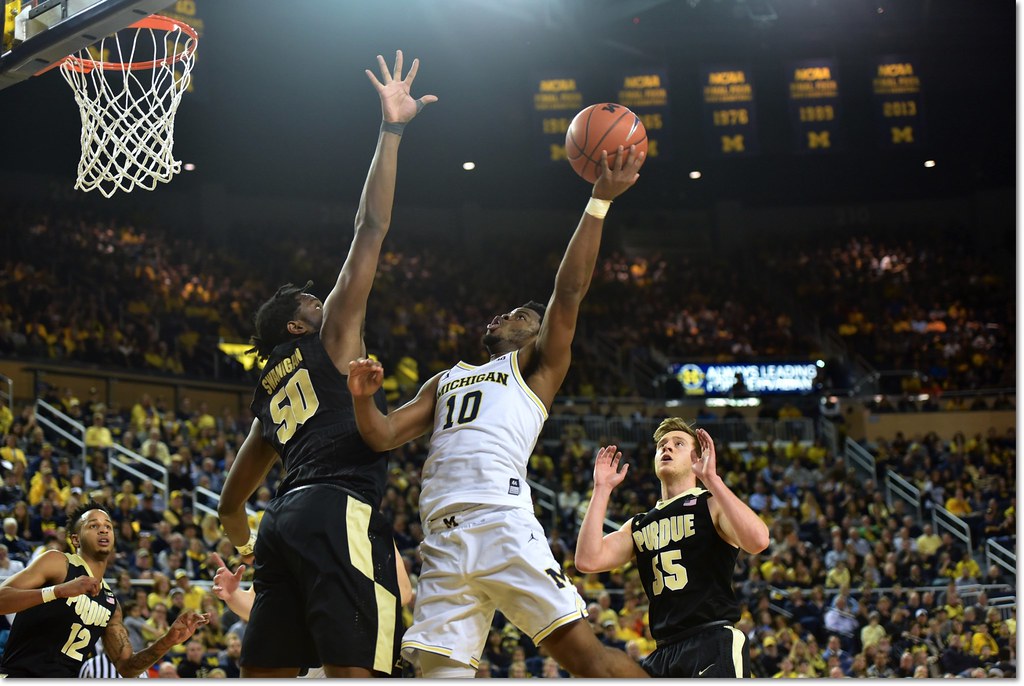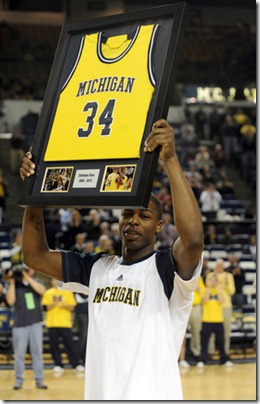deshawn sims

Previously: Part One
After looking at Michigan's stellar pick-and-roll production and how they do it last week, I dove deeper into Synergy's database to try to put this year's team in a historical context. At first I was just looking at other lead ballhandlers, then I was putting tables for every season together, then I realized I needed to add the screeners to the equation and look at how each team varied their P&R attack to do this right.
So what was going to be the second half of this series is now the second of either three or four parts. I'm trying not to make these too long to digest. These posts are going to be heavy on Synergy's stats, so I want to make a few notes before going any further.
While Synergy uses the terminology "points per possession" to describe how they measure production, that's very misleading when you're used to looking at KenPom. I'm switching over to describing Synergy stats as "points per play." The distinction is described in this useful Cleaning The Glass post:
CTG distinguishes between possessions and plays, and this distinction is important when diving into context information. A possession starts when a team gets the ball and ends when they lose it. A play ends when the team attempts a shot, goes to the foul line, or turns the ball over. If a team gets an offensive rebound, that results in a continuation of a possession but a new play. So a possession can have multiple plays.
Play contexts are per-play, not per-possession. For example, a team might come down in transition and miss a shot, get the offensive rebound, kick it out, and run a halfcourt set. Then might miss that shot but get a tip in to score and end the possession. That was all one possession, but three different plays and three different contexts: the first shot was in transition, the second in the halfcourt, and the third was a putback.
Because offensive rebounds start a new "play" within a possession, points per play are inherently going to be lower than points per possession. To help contextualize, I've included each player's national percentile rank for that season along with their stats.
For ballhandlers, "own offense" includes plays that finish with a field goal attempt, shooting foul, or turnover. "Passes" measure the result of shots that come as a direct result of the ballhandler's pass out of the pick-and-roll. "Keep percentage" is a stat I added myself that simply measures the percentage of a time the ballhandler uses his own offense instead of recording a passing play—Michigan has had players arrive at similar efficiency despite sporting very different styles.
an enjoyable pick-and-pop example
For screeners, you mostly just need to know the difference between popping, rolling, and slipping a screen:
- Popping: setting the screen and then stepping out (usually to the three-point line) for what's almost always a spot-up shot. Occasionally a more versatile big man will drive off a pop. Think Moe Wagner.
- Rolling: setting the screen and then going to the basket in the hopes of getting a layup/dunk. Think Jordan Morgan.
- Slipping: faking the screen before running to a predesignated spot—usually the rim, sometimes spotting up if it's a Wagner-type or perimeter player—as a changeup to keep defenses from overplaying the ballhandler.
As a general rule, points per play are going to higher when the screener finishes the play than the ballhander because of the nature of the pick-and-roll. A pass is usually going to be thrown to an open man when the play works; while the ballhandler could take a shot because he got open himself, he also usually has to finish the play if it's well defended.
Consider the degree of difficulty of Zavier Simpson's or Cassius Winston's shots; it's hard to be a really efficient scorer off the pick-and-roll. Morgan, while a great roll man, often just had to catch the ball and finish an uncontested shot at the rim. Most of Wagner's pick-and-pop threes went up without a real shot contest. This makes sense: there's little reason to pass the ball to your big man if he isn't open. Teams also often default to a quick screen in late clock situations, which tends to create more difficult shots the ballhandler has little choice but to take.
The other thing to note in the screener stats: under number of plays in each category, "%" shows the percentage of the time each player popped, rolled, or slipped out of their overall screener plays used. The "%ile" under points points play in each category, however, measures percentile national rank. I realize this is a little confusing but I couldn't come up with a better way than Synergy in this case.
With that out of the way, let's dive in.
[Hit THE JUMP for a year-by-year history of Michigan's pick-and-roll offense and what we can learn from it.]

This was a good year for seniors. [Marc-Gregor Campredon]
Previously: All-Bench, Bench Mob, All-Freshman
John Beilein has spent ten seasons in Ann Arbor. As of the most recent, he's the winningest coach in program history with 215. He snapped Michigan's post-sanction tournament drought in 2009, the first of seven NCAA appearances with the Wolverines, three of which have extended at least into the second weekend.
In recognition of the above, as well as the need for offseason #content, I've put together a series of All-Beilein teams, inspired by this twitter post and the ensuing conversation. My guidelines:
- I'm attempting to put together the best possible lineups, which isn't necessarily the same as picking the best individual players at each spot.
- I'm choosing individual player vintages (i.e. 2013 Trey Burke). A player can only be chosen once for each category, but different player years (i.e. freshman bench gunner 2014 Zak Irvin and well-rounded senior 2017 Zak Irvin) can be eligible for separate categories.
- The same player/year can be chosen for multiple categories—for instance, 2013 Mitch McGary making the All-Bench team doesn't exclude him from making the final All-Beilein team.
Eligibility for certain categories may be slightly fudged because of the limited pool of players.
I'm not putting too many constraints on myself for this exercise since the point is to let our imaginations run wild. Today's list is the logical counterpart to the previous All-Freshman squad: here are the best senior seasons from Beilein's players. Could I fill out a full second team? Well, no. No I couldn't.
POINT GUARD: 2016-17 DERRICK WALTON

It all came together for Walton in his final season. [Bryan Fuller]
Might I recommend the 5000-word version of this blurb? For those who don't have time, a relevant sampling:
Walton had spent his time at Michigan as the consummate teammate, always looking to get his talented teammates going before seeking his own shot. At the same time he called upon his team to step up and make plays, he embraced calling his own number.
"He’s really become the guard that he always wanted to be and we always wanted him to be. It’s not that he’s been bad in between. It’s just that he’s such a great, unselfish player who’s always about the team. I think he convinced himself that if it’s really about the team, then I need to do more." — John Beilein
The swaggering star of Chandler Park Academy and the blacktops of Detroit was reborn in maize and blue. This Walton fought through contact for and-one buckets. He made inch-perfect assists, whether hitting a slipping big man in stride, two-handing a 35-foot bounce pass, or launching an 80-foot outlet over the top. He hit pull-up threes over rubber-kneed defenders and let them hear all about it on the way back down the court.
After a promising freshman season was followed by an injury-plagued sophomore year and underwhelming junior campaign, Walton transformed as a senior into the best Michigan point guard to play for Beilein, Trey Burke excepted—and Walton was so good down the stretch that you could almost (almost) eliminate that caveat. I could watch this all day:
The early NBA departures of Burke and Darius Morris didn't leave much in the way of competition for this spot. That doesn't make Walton's senior year any less spectacular.
[Hit THE JUMP for the rest of the lineup.]
See also: what this is, hockey nominees.
Zack Novak
PROS: If he was a Football Manager player, would have an influence and work rate of 20. This means he's a gritty grittenstein who everyone loves because he defies his physical limitations to be pretty good. Had an Aneurysm of Leadership to lead Michigan to its first victory in Breslin since 1997.
Also nailed six threes in that game. Iconically bled all over himself in a game against Illinois during Michigan's first tourney push since the program's NCAA immolation. Kind of a walking capital-L Leadership avatar. The kind of player opposing fans loathe. Our Brian Cardinal. Swears like a sailor and has problems keeping his emotions in check.
Can dunk!
CONS: Was never a star. Senior year usage was 14.3%, in the "role player" arena. Repeatedly posterized by men a half-foot taller than him, though this could be filed under a positive from a grit perspective. Clocked an OSU player late in a loss to get booted.
Darius Morris
PROS: Amazing sophomore year saw him finish top five in assist rate nationally and shoot efficiently despite an astronomic usage rate. Told Kalin Lucas to get off his #$&*ing court, and Lucas had to since Michigan had just swept Michigan State for the first time since paper was invented. Was the engine of Michigan's second tourney birth since the NCAA immolation, this one not a skin-of-your-teeth bubble nailbiter. Nearly led Michigan to an upset of Duke in the secound round. If only that floater had dropped…
CONS: Made a poor decision to enter the draft early, limiting his impact to that one year—his freshman year was not exactly Trey Burke's. Draft entry decision seemingly taken in full knowledge that he was unlikely to go in first round. That's tough to take, and it seems like a one-year phenom has to be more phenomenal to get in here.
Also while it's not his fault that Tim Doyle called him "butterfly," it is a regrettably true thing.
Manny Harris
PROS: Best player on Michigan's tourney-drought-breaking team, with massive usage (32%, top 25 nationally), a nearly-as-massive assist rate, and okay shooting. Major factor in the win at Minnesota that essentially got Michigan into the tourney.
A guy who signed up with Michigan when he had other options and there wasn't much reason to be a Wolverine. Stuck with it despite the Amaker firing. Way less crazy than Alex Legion. Actual full name is "Corperryale L'Adorable Harris," which… wow. Key guy in Michigan's perception-altering wins over UCLA and Duke in 2009.
CONS: Also made a debatable-at-best decision to enter the draft early and has spent his NBA career on the fringes of the Cavs' roster. Had blowups with Beilein that caused him to sit during critical periods. Tended toward lazy habits like jacking up contested threes. Had a little Rasheed Wallace disease while at M wherein he seems like less than he should be. Michigan disappointed greatly in his final year despite losing only a couple of walk-ons and Kelvin Grady.
Daniel Horton
PROS: Yeah, he's eligible. If this is a surprise it just goes to show how long ago 2006 seems in basketball terms.
Horton's teams never made the tournament but in his last go-round he was the main man on an outfit Kenpom likes better (#31) than a couple of Beilein outfits that got in. And he was fantastic: 28% usage the #35 assist rate, a bunch of steals, 90% free throw shooting, 49% from two, and 39% from three. That team would have made the tourney if they a) hadn't gone from 16-3 to 18-10 to end the year and b) hadn't blown it against Minnesota in the Big Ten tournament.
I think we all forget how good Horton was because his teams never got anywhere.
CONS: Teams never got anywhere. He's holding the NIT MVP trophy above, a career-summing photo if there ever was one. While this isn't his fault it is a downer. Got suspended for most of his junior year thanks to a domestic violence thing he pled guilty to.
DeShawn Sims
This was difficult to separate out since there are a number of candidates with things to recommend them: Brent Petway, Graham Brown, and Stuart Douglass were tough to leave out, but they all seemed like junior versions of Novak in the grit category.
PROS: The other top banana on Michigan's drought-breaker. A skilled power forward forced to play out of position at center too much, Sims was a wildly inconsistent player capable of dropping 20 on 8 shots one night and 2 on 8 the next night. These swings correlated very well with the height of his opponent. Are you a below-the-rim 6'8" kid at Northwestern? Forget it. Are you a shotblocker? Enjoy your feast.
Sims came back from an unimaginable personal tragedy—his brother was shot to death—endured during his freshman year to be a mainstay for his final three years. He was high-usage, a quality rebounder, and rarely turned the ball over. These things made up for some eh shooting percentages to make him an efficient player. Another guy who had options but decided to go with Michigan at a time where there was little reason to.
CONS: Has the same knock Manny Harris did since his final year was the disappointing follow-up to the tourney appearance. Was never a really great player and doesn't bring Novak-level fan intangibles (FANTANGIBLES!) with him.
![2009-0104-ad-umbball237[1] 2009-0104-ad-umbball237[1]](https://mgoblog.com/sites/mgoblog.com/files/images/MGoHall-of-Fame-Basketball-Nominees_9F28/2009-0104-ad-umbball2371_thumb.jpg)
![medium_321novak[1] medium_321novak[1]](https://mgoblog.com/sites/mgoblog.com/files/images/MGoHall-of-Fame-Basketball-Nominees_9F28/medium_321novak1_thumb.jpg)
![NITMICHIGAN_t440[1] NITMICHIGAN_t440[1]](https://mgoblog.com/sites/mgoblog.com/files/images/MGoHall-of-Fame-Basketball-Nominees_9F28/NITMICHIGAN_t4401_thumb.png)
![images[1] images[1]](https://mgoblog.com/sites/mgoblog.com/files/images/MGoHall-of-Fame-Basketball-Nominees_9F28/images1_thumb.jpg)

![95581892_display_image[1] 95581892_display_image[1]](https://mgoblog.com/sites/mgoblog.com/files/images/MGoHall-of-Fame-Basketball-Nominees_9F28/95581892_display_image1_thumb.png)
2